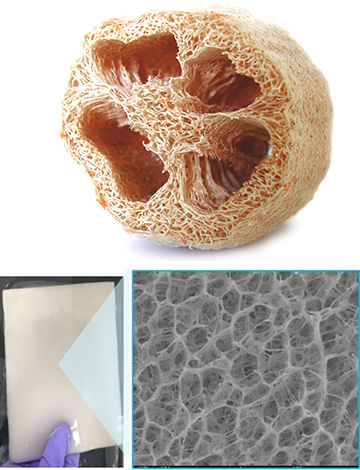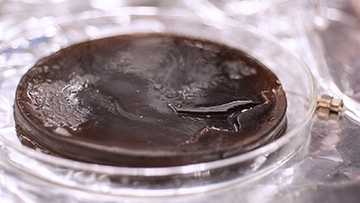![]()
Researchers Néhémie Guillomaitre (left) and Xiaohui Xu, with a sample of the Princeton team’s thermoresponsive hydrogel. The team believes the hydrogel can provide a high-productivity method for solar-powered water purification. [Image: Bumper DeJesus/Princeton University]
Researchers have worked for centuries on a range of techniques to put solar energy to work providing safe, drinkable water. A team from Princeton University, USA, has now dropped a novel candidate into the mix—a hydrogel sponge that, powered by nothing but sunlight, reportedly can suck up polluted water and photothermally release ample volumes of pure, pollutant-free H2O (ACS Cent. Sci., doi: 10.1021/acscentsci.2c01245).
The research team believes its high-tech hydrogel—the structure of which was inspired by a loofah sponge—can be scaled up to the point where it could enable solar-driven water purification sufficient to meet a person’s daily needs, even on cloudy days. That, the authors conclude, suggests the material’s potential to “provide facile and affordable access to clean water in a sustainable, low-energy way to the world’s population.”
Evaporation’s shortcomings
The history of sunlight-driven water production goes back hundreds of years. The first recorded use of solar stills—passive devices for harvesting sunlight to evaporate and distill water—dates to 1551. More recently, researchers have looked at enhanced methods for using solar energy to turn water into steam for distillation, and for leveraging technologies such as plasmonics and novel material structures to speed up the process.
The problem with many of these evaporation-based techniques, according to the researchers behind the new study, is that even with techniques to concentrate solar energy, it’s hard to push them to production rates sufficient to meet a person’s daily needs. The Princeton team and other research groups have thus been looking at thermoresponsive hydrogels—a special variety of cross-linked, water-logged polymer—as an alternative platform.
Hydrophilic-hydrophobic switching
One advantage of such hydrogels is that they can be chemically tuned to absorb water at a low temperature and then, when photothermally heated under sunlight, expel the water at a comparatively rapid rate. Gels such as poly(N-isopropylacrylamide) (PNIPAm) achieve this feat by switching from hydrophilic, or water-attracting, properties to hydrophobic, or water-repelling, properties at a specific, critical solution temperature. And additional chemical layers can be added to filter out pathogens, heavy metals and organic molecules, making the expelled water cleaner than the water originally absorbed.
Promising as the technique might seem, however, current hydrogel technology for solar-driven water purification has faced some stumbling blocks. While potentially more productive than evaporative techniques, most hydrogel-based purification systems can produce only a few gallons of pure water a day, well below minimum recommended per-person amounts. And they can become gummed up at the surface by the same nasty pollutants they’re so effective at filtering out from the water.
Learning from the loofah

[Top: A loofah sponge. Bottom: Open-pore structure of the loofah-inspired hydrogel from the Princeton team. [Image: J.C. Mann/Wikimedia Commons (top); adapted from ACS Central Science 2023, DOI: 10.1021/acscentsci.2c01245 (bottom)]
In work published in 2021, researchers led by Rodney Priestly, a professor of chemical and biological engineering at Princeton, and postdoctoral research scientist Xiaohui Xu prototyped a hydrogel sponge with a honeycomb-like structure that the authors said produced the highest passive solar-water purification rate reported yet. But the team wanted to boost the device’s performance still further, to bring its output closer to a person’s actual daily demand for water.
To get there, the team looked to a natural model: the loofah sponge. These familiar bath accessories are made from sun-dried, fully ripened natural loofah fruits. Internally, they have an open-pore structure that makes them very efficient water-absorbers. The team realized that those same properties, realized in a thermoresponsive hydrogel, could dramatically improve water transport in a hydrogel-based purification scheme.
Making an open-pore system
To test out the idea, the team coaxed conventional PNIPAm hydrogels into an open-pore, loofah-like structure using free-radical polymerization in the presence of varying amounts of the organic compound ethylene glycol (the same ingredient found in car antifreeze solution). They tweaked the chemistry to create a thermoresponsive, loofah-style hydrogel with a critical temperature of 34 °C. Below that temperature, the gel would show hydrophilic, water absorbing behavior; above it, the gel would become hydrophobic and start expelling water.
The researchers also used in situ polymerization to layer on additional substances to the loofah-like hydrogel to improve its qualities as a water purifier. One layer consisted of polydopamine (PDA), which the team had used on its previously reported hydrogel, to improve the system’s efficiency at converting sunlight to heat, and also to serve as a filter to keep out heavy metals and organic molecules.

A close-up of the Princeton team’s water-purifying hydrogel. [Image: Bumper DeJesus/Princeton University]
The researchers also added a network of poly(sulfobetaine methacrylate) (PSBMA) molecules, creating a superhydrophilic layer that absorbs water but repels oil droplets. That, the researchers hoped, would forestall the surface fouling by filtered pollutants that had plagued earlier systems, allowing the system to be effectively “self-cleaning.”
Efficient water-cleaner
The team tested the loofah-inspired solar water purifier by tossing it into a contaminated water source, allowing it to swell with absorbed water, and then placing it under sunlight to rise above the critical temperature and analyzing the expelled water for purity.
The researchers found that as the sun-heated sponge rose to and surpassed its critical temperature, it began producing water after a four minute lag, and had expelled some 70% of the absorbed water within 10 minutes—a production rate an order of magnitude faster than conventional PNIPAm hydrogels. Moreover, even under light levels simulating a cloudy day, the gel took only slightly longer (15 to 20 minutes) to expel a similar amount of water. And the device was found to be effective at filtering out heavy metals, oils and microplastics—with noticeably less fouling, owing to the oil-repelling PSBMA layer.
The team believes that the solar-absorbing hydrogel can ultimately be improved and scaled up to provide a practical source of clean water without tapping the electrical grid—offering “a new paradigm for solar water production with the potential to meet daily human demand.” Team leader Priestly has co-founded a startup, AquaPao, that aims to further improve and eventually commercialize the technology.
